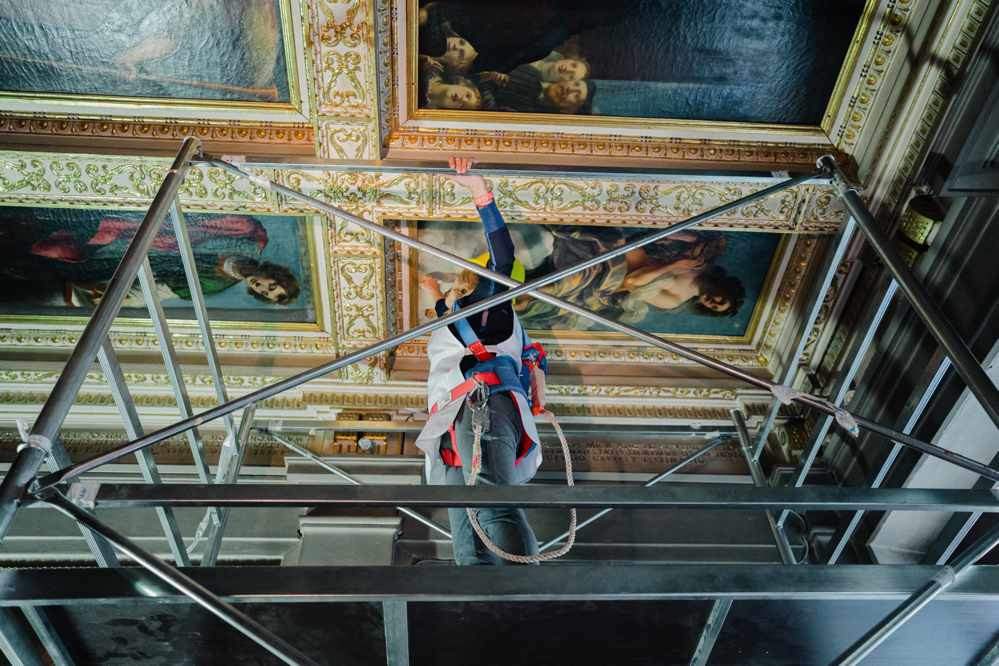Restoration of Artemisia's Allegory of Inclination begins. Veils off only virtually
The restoration of Artemisia Gentileschi’s Allegory of Inclination, the painting that the artist made in about 1615-1616 and which can be seen on the ceiling of the Gallery in which episodes from Michelangelo’s life are also located, is under way at Casa Buonarroti. The allegory was one of the first in the room to be commissioned by Michelangelo the Younger and depicts a young woman holding a compass while a star acts as her guide. The female figure was originally painted completely nude, but a few decades later, a descendant of Michelangelo the Younger had the Volterrano cover the figure with moralistic drapery. The work, now removed from the ceiling of the museum’s Gallery, will be restored in public until April 2023, directly in the Museo di Casa Buonarroti.
The restoration project titled Artemisia Unveiled / Artemisia Unveiled relies on the support of British nonprofit Calliope Arts and collector and philanthropist Christian Levett. The use of cutting-edge diagnostic and imaging technologies will allow the original appearance of the painting created by Artemisia to be virtually restored. The project also includes aconcluding exhibition at Casa Buonarroti, scheduled from September 2023 to January 2024, and the renovation of specific areas of the museum, as well as the redesign of the Gallery’s lighting. The project is a collaboration between the Foundation and Calliope Arts, a nonprofit based in Florence and London, and the main supporters are Calliope Arts co-founders, philanthropists and lawyers Margie MacKinnon and Wayne McArdle, and art collector Christian Levett, founder of the Mougins Museum of Classical Art and the Levett Collection house-gallery in Florence.
“Seeing the Tilt painted by Artemisia coming down from the ceiling, and, you can well imagine, for the first time since the painter had painted it in 1616, was a very strong emotion,” commented the president of the Casa Buonarroti Foundation, Cristina Acidini. “This is the beginning of a great project for which the Casa Buonarroti Foundation is especially grateful to its generous supporters.”
"Thanks to photographic footage, diagnostic imaging and careful analysis, we will be able to establish the exact technique used by Artemisia, detect exactly the condition of thework and define our intervention project for the painting," says restorer Elizabeth Wicks leading the team of expert technicians and restoration workers, under the supervision of Casa Buonarroti Director Alessandro Cecchi and Jennifer Celani, an official of the Soprintendenza Archeologia Belle Arti e Paesaggio for the metropolitan city of Florence and the provinces of Pistoia and Prato. “While a removal of the Volterrano’s now-historicized repainting is unthinkable, it will still be possible, thanks to state-of-the-art instrumentation, to create a virtual image of the original work hidden beneath the painting we see today,” explains restorer Wicks. “Next week we will begin our virtual journey beyond the veil, with diffuse and grazing light examination, followed by UV and infrared research. Hypercolorimetric multispectral imaging will help us better understand the original execution technique and later additions. This will be followed by X-ray and high-resolution reflectography.”
“This project aims to virtually restore the original version of Artemisia’s first Florentine work and investigate what lies beneath Volterrano’s additions,” added supporter Wayne McArdle. “What is the condition of the original painting and canvas? What will we discover about Artemisia once it is unveiled? These are the questions at the heart of the project, and we are excited to be able to follow this restoration journey in hopes of finding all the answers.”
Until April 2023, during museum opening hours, the public will be able to observe the progress of the restoration of theAllegory of Inclination in the space set up inside the Model Room of the San Lorenzo facade in Casa Buonarroti. Every Friday, the restorer will answer questions from the public. In addition to the ongoing restoration, visitors will also find the newly refurbished Marble Room and Michelangelo’s Madonna of the Staircase and Battle of the Centaurs, restored through the Friends of Florence.
“We would like to look at this project as the beginning of something bigger,” said Christian Levett. “In addition to the restoration of the painting, the project includes a renovation of the museum’s entrance, revamping the signage and redesigning the Gallery’s lighting. The museum has a wonderful story to tell, and we literally want to put it in the spotlight.”
“The restoration and research project on Artemisia’s work is just the beginning of a larger work that will result in an exhibition at Casa Buonarroti, planned between September 2023 and January 2024,” explains museum director Alessandro Cecchi. “The exhibition will highlight the outcomes of the restoration and explore the context related to the creation of the painting, including the value of Artemisia’s Florentine debut and her relationships with Grand Duke Cosimo II de’ Medici and the city’s cultural milieu.”
Photo by Olga Makarova
 |
| Restoration of Artemisia's Allegory of Inclination begins. Veils off only virtually |
Warning: the translation into English of the original Italian article was created using automatic tools. We undertake to review all articles, but we do not guarantee the total absence of inaccuracies in the translation due to the program. You can find the original by clicking on the ITA button. If you find any mistake,please contact us.





























